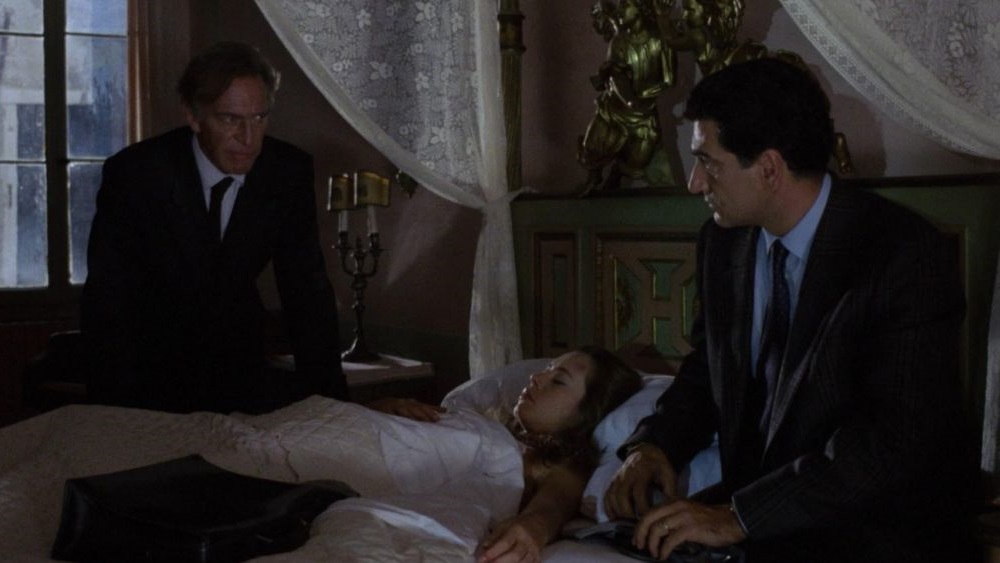NOSFERATU IN VENICE. Return of the Vampire

In this unofficial sequel to Werner Herzog’s “Nosferatu the Vampyre” (1979) – a remake of F.W. Murnau’s “Nosferatu: A Symphony of Horror” (1922) – the charismatic Klaus Kinski reprised his famous role, joined by Barbara De Rossi, Christopher Plummer, and Donald Pleasence. However, the film “Nosferatu in Venice” is hard to categorize as successful.
Set in contemporary Venice, the story revolves around Professor Paris Catalano, a British scholar who has devoted his entire life to studying Nosferatu. At the request of Princess Helietty, heiress to the ancient Transylvanian Canins family, Catalano arrives in the city. Helietty suspects that the mythical vampire, who disappeared without a trace two centuries ago during a Venetian carnival, may rest in a sealed tomb in the underground of the family estate. Despite Catalano’s advice against opening the grave, the Canins family organizes a seance to uncover the truth about Nosferatu’s fate. As a result, the vampire awakens from a two-hundred-year slumber and escapes from his tomb, eventually arriving in Venice. Catalano believes that the bloodsucker, tormented by constant pursuit of sustenance and immortal life in solitude, now desires only death. The professor sees an opportunity to defeat Nosferatu through the love of a virgin, and since it’s the 1980s, the only virgin around is Maria, Helietty’s teenage sister.

Italian producer Augusto Caminito made a fortune with low-budget films targeting foreign markets. In 1985, he decided to produce a horror film based on a script by Carlo Alberto Alfieri. Originally conceived as a sequel to Werner Herzog’s “Nosferatu the Vampyre,” the film managed to secure Klaus Kinski for the titular role, and Maurizio Lucidi was initially chosen as the director. However, problems began to surface. First, Caminito changed his mind and wanted a more experienced director, so he replaced Lucidi with Pasquale Squitieri. Squitieri, in turn, lost his job after altering the script and quarreling with Kinski. Mario Caiano was then considered, but he left the set after a few days following a dispute with the actor. Ultimately, despite lacking experience, Caminito directed the film himself to avoid bankruptcy, as all the mentioned directors had already received full payment.
The troubles didn’t end there. Kinski, known for his capricious nature, refused to shave his head and wear fake claws, iconic elements of Herzog’s Nosferatu. This explains why the vampire in Caminito’s film looks as if he just stepped out of a manicurist, making a detour to the hairdresser. The actor also disregarded the filmmakers’ instructions and refused retakes. As a result, cinematographer Antonio Nardi had to repeatedly readjust the lighting on set because Kinski had his own concept of where he should enter the frame. Kinski also forced Caminito to shoot many unused scenes of Nosferatu walking the streets of Venice. Worse still, Kinski sexually assaulted two actresses, biting one in the crotch. After six weeks of filming, the entire budget was exhausted, and Caminito had only shot half of the planned material, so he had to compile the entire film from what he had.

The chaos on set is reflected in the film itself. “Nosferatu in Venice” is so inconsistent and nonsensical that it’s hard to believe it was screened at the Venice Film Festival in 1988 (albeit out of competition). Apart from the titular character and Kinski’s role, it has nothing in common with Herzog’s film or Murnau’s original. In the endings of both those films, Nosferatu crumbled to dust under sunlight, while here he strolls through Venice in broad daylight. The only strong point of this tangled film, full of unnecessary scenes and strange characters that appear and disappear without explanation, is the cinematography. The atmospheric shots, capturing the fog-shrouded Venice through Nardi’s lens, present the city beautifully: mysterious and impenetrable. Almost like in the excellent “Don’t Look Now” by Nicolas Roeg, to which “Nosferatu in Venice” doesn’t come close.

